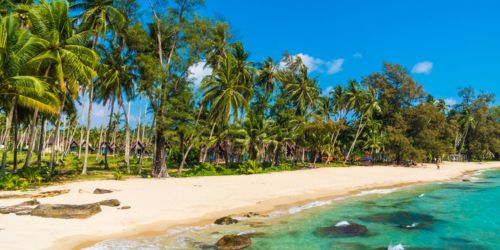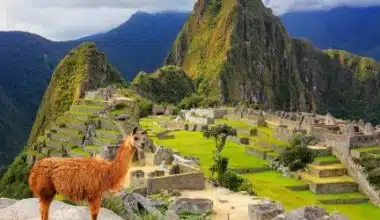Explore Costa Rican beaches, where nature meets paradise, with azure waters, golden sands, and lush rainforests. Discovering what makes one of these pristine coastlines stand out as the best Costa Rica boasts numerous beautiful beaches, each with its own unique features. In this article, we will list the best beach destinations in Costa Rica to visit as well as recommendations for where to stay during your vacation.
Best Beach In Costa Rica
Costa Rica is home to many beautiful beaches, each with its own unique features. These beaches are renowned for their natural beauty and diversity and there are several top-rated beaches in Costa Rica. Costa Rica’s beaches provide a wide variety of experiences to suit any traveler’s preferences, whether you’re looking for relaxation, adventure, or a combination of the two.
The best beaches in Costa Rica are:
#1. Manuel Antonio Beach, Manuel Antonio National Park
This beach, which is on the Pacific coast, is renowned for its unspoiled beauty, with its white sand, crystal-clear waves, and thick rainforests as a backdrop. Swimming, tanning, and animal viewing are all excellent activities there.
#2. Ostional Beach, Nicoya Peninsula
This black sand beach is part of the Ostional National Wildlife Refuge and is known for its olive ridley sea turtle nesting. Visitors can witness the incredible sight of thousands of turtles coming ashore to lay their eggs.
#3. Playa Santa Teresa, Nicoya Peninsula
This off-the-beaten-path beach is a favorite among surfers and vacationers. It offers great waves for surfing and a laid-back atmosphere. It’s a perfect spot to relax, enjoy the sun, and take in the beautiful surroundings.
#4. Playa Cocolito
Located on the Pacific coast, Playa Cocolito is a quiet beach with stunning turquoise waters and pink rocky cliffs. It’s a great place for swimming, snorkeling, and horseback riding.
#5. Playa Tortuguero
Situated in Tortuguero National Park on the Caribbean coast, this beach is a haven for turtle lovers. It’s a protected sanctuary where green sea turtles and hawksbill turtles come to nest from July through October.
#6. Playa Grande
Playa Grande, which is on the Pacific coast, is well-known for its attractive palm palms and powerful surf. There is a chance to see endangered green macaws at this well-liked surfing location.
#7. Playa Montezuma
The bohemian beach hamlet of Playa Montezuma, which is located on the Nicoya Peninsula’s southernmost point, has a relaxed atmosphere. It provides options for trekking and exploring, as well as beautiful beaches and waterfalls.
#8. Playa Conchal
Located on the Pacific coast, this beach is famous for its unique sand made up of tiny crushed seashells. It offers crystal-clear turquoise waters, great snorkeling opportunities, and is surrounded by lush vegetation.
#9. Playa Flamingo
Another beautiful beach on the Pacific coast, Playa Flamingo, is known for its pristine white sand and calm, clear waters. It’s a popular spot for swimming, sunbathing, and enjoying water activities such as kayaking and paddleboarding.
#10. Playa Hermosa
Playa Hermosa, a long and broad beach in the Guanacaste region, is well-known for its exceptional surfing conditions. In addition to being a fantastic site to unwind and take in the landscape, it also holds international surfing events.
Best Beach In Costa Rica For Swimming
The best beaches in Costa Rica for swimming are the coastal areas with calm waters, clear water, sandy bottoms, amenities, safety, and scenic beauty. These beaches offer a safe and enjoyable swimming experience for locals and tourists, with a diverse range along the Pacific and Caribbean coasts. Costa Rica’s top swimming beaches include Playa Punta Uva, Tamarindo, Manuel Antonio, Flamingo, Conchal, Samara, Hermosa Guanacaste, San Juanillo, and Conchal. Playa Flamingo, Conchal, Samara, Hermosa Guanacaste, and San Juanillo offer unique experiences. Visitors should always exercise caution, adhere to safety guidelines, and be aware of their swimming abilities.
The safety of swimming at the best beaches in Costa Rica is attributed to several factors which include
#1. Calm Waters
Many of Costa Rica’s best beaches for swimming are located on the Pacific Coast, where the waters tend to be calmer and more predictable, making them safer for swimmers, especially those with limited experience.
#2. Protected Bays
Some beaches are situated within protected bays or coves, shielding them from strong currents and waves and creating a more tranquil environment for swimming.
#3. Lifeguard Services
Popular swimming beaches often have lifeguard stations, where trained professionals monitor the water, providing assistance and ensuring swimmers’ safety.
#4. Safety Flags
Beaches with lifeguards use a flag system to indicate water conditions. Green flags signify safe swimming conditions, while red flags warn of strong currents or dangerous surf.
#5. Visible Markers
Buoy markers and safety ropes may be in place to guide swimmers and keep them within safe areas.
#6. Shallow Areas
Many of these beaches have gradual entries into the water, with shallow areas near the shore, making them suitable for children and less experienced swimmers.
#7. Rip Current Awareness
Signs and educational materials at the beach often provide information about rip currents, helping swimmers recognize and avoid them.
#8. Local Knowledge
Lifeguards and residents often have a deep understanding of the beach’s specific conditions and can offer valuable advice to beachgoers.
#9. Tourist Infrastructure
Beaches frequented by tourists tend to have well-developed infrastructure, including safety measures, clear signage, and amenities like restrooms and first aid stations.
#10. Weather Monitoring
Many coastal areas in Costa Rica have weather monitoring systems in place to detect approaching storms or adverse weather conditions, allowing for timely warnings and evacuations if necessary.
Best Beach In Costa Rica For Families
The best beaches in Costa Rica for families offer a combination of family-friendly amenities and natural beauty. Beaches like Playa Conchal, Manuel Antonio Beach, and Playa Samara are known for catering to families, offering a mix of safe swimming conditions, nearby amenities, and the natural beauty that Costa Rica is famous for.
The Features Best Beach in Costa Rica for Families
#1. Gentle Waves
These beaches have calm, gentle waves that are safe for children to swim and play in.
#2. Shallow Waters
Many family-friendly beaches have shallow areas near the shore, making it easy for young children to wade and splash.
#3. Lifeguards
Beaches with lifeguard services provide an extra layer of safety for families, ensuring a watchful eye on the water.
#4. Playgrounds
Some beaches have adjacent playgrounds where kids can enjoy swings, slides, and other recreational equipment.
#5. Picnic Areas
Picnic tables and shaded areas are often available for families to have a comfortable and enjoyable day at the beach.
#6. Restrooms and Changing Facilities
Well-maintained facilities are essential for families, including clean restrooms and places to change.
#7. Kid-Friendly Activities
There are beaches with nearby activities like beach volleyball, kayak rentals, or horseback riding suitable for children.
#8. Wildlife and Nature
Family-friendly beaches in Costa Rica often provide opportunities for kids to observe wildlife and explore tide pools.
#9. Family-Friendly Accommodations
Many family-oriented beach towns offer a range of accommodations suitable for families, from resorts to vacation rentals.
#10. Cultural Experiences
Some beaches are located near towns with cultural attractions and family-friendly restaurants, allowing for a well-rounded experience.
Best Beach In Costa Rica Near San Jose
Travelers often seek out these beaches in Costa Rica near San Jose as convenient getaways from the urban environment of San Jose to enjoy activities such as swimming, sunbathing, surfing, snorkeling or simply relaxing in a picturesque coastal setting. While Costa Rica is known for its stunning beaches across the country, the ones near San Jose are particularly popular for residents and tourists looking for day trips or weekend escapes without traveling long distances. These beaches offer a mix of natural attractions, cultural experiences, and a variety of amenities to cater to different interests and preferences.
Costa Rica’s beaches near San Jose include Jaco Beach, Punta Uva, Montezuma Beach, San Juanillo Beach, and Playa Nosara. Jaco is known for its lively nightlife, while Punta Uva offers stunning Caribbean coast beaches. Other popular beaches include Limoncito Beach, Playa Mantas, and Playa Herradura.
Benefits Of Best Beach In Costa Rica Near San Jose
The best beaches in Costa Rica near San Jose offer numerous benefits to travelers and locals
#1. Accessibility
Beaches near San Jose offer the advantage of being easily accessible for both locals and tourists. They are within a reasonable driving distance, making them convenient for day trips or weekend getaways.
#2. Time-Saving
Being closer to San Jose means less travel time, allowing visitors to spend more time enjoying the beach and less time on the road. This is particularly beneficial for those with limited vacation time or those who prefer shorter travel distances.
#3. Variety of Amenities
Beaches near San Jose often have a range of amenities and services available nearby. This can include restaurants, hotels, beachfront bars, and shops, providing convenience and comfort to beachgoers.
#4. Outdoor Activities
Visitors can engage in a range of outdoor activities, including swimming, surfing, snorkeling, hiking, and wildlife watching, making them ideal destinations for adventure enthusiasts.
#5. Eco-Tourism and Sustainability
Some beaches prioritize eco-friendly practices and sustainable tourism, promoting the protection of the local environment and wildlife.
#6. Cultural attractions
San Jose, the capital city of Costa Rica, offers a wealth of cultural attractions, museums, and historical sites. Being near San Jose allows visitors to combine their beach experience with exploring the city’s vibrant culture, cuisine, and architecture.
#7. Relaxation and Wellness
Some beaches offer wellness retreats, spa services, and yoga studios, creating an ideal environment for relaxation and rejuvenation.
#8.Natural Beauty
These beaches often showcase Costa Rica’s stunning natural beauty, with pristine coastlines, lush surroundings, and breathtaking mountain or rainforest backdrops.
#9. Day Trip Opportunities
Proximity to San Jose provides the opportunity for day trips to the beach, allowing visitors to enjoy the beauty of the coastline and return to the city in the evening. This flexibility can be convenient for those who want to experience both urban and beach environments during their stay.
#10. Community Engagement
Visiting these beaches also supports the local communities in beach towns, contributing to the local economy and fostering positive interactions between tourists and residents.
Best Beach In Costa Rica For Snorkeling
If you’re looking for the best beach in Costa Rica for snorkeling, consider beaches such as Cahuita National Park, Playa Punta Uva, Manuel Antonio National Park, and Gandoca-Manzanillo National Wildlife Refuge.
Tips To Keep In Mind During Snorkeling In Costa Rica
When snorkeling on the best beaches in Costa Rica, here are some tips to keep in mind:
#1. Safety First
Before snorkeling, ensure that you have basic swimming skills and are comfortable in the water. It’s also important to check the local weather conditions and any potential hazards, such as strong currents or rocky areas.
#2. Check the Water Conditions
Before entering the water, assess the current, visibility, and tide conditions. If the water is rough or visibility is poor, it may not be ideal for snorkeling. It’s best to choose days with calm seas and good visibility for a better experience.
#3. Bring or Rent Snorkeling Gear
Bring your snorkeling equipment, including a mask, snorkel, and fins, for a comfortable and personalized snorkeling experience. If you don’t have your gear, you can often rent it from local shops or tour operators.
#4. Go with a Guide
If you’re new to snorkeling or unfamiliar with the area, consider going on a guided snorkeling tour. Local guides can provide valuable insights, ensure safety, and help you explore the best snorkeling spots.
#5. Respect marine life
As a guest in the underwater ecosystem, avoid disturbing marine life and maintain a safe distance while observing from a respectful distance.
#6. Snorkel During the Right Time of Day
Snorkeling early in the morning or later in the afternoon can often provide better visibility and less crowded conditions. This is especially true for popular snorkeling spots.
#7. Protect Yourself from the Sun
Apply a reef-safe sunscreen to protect your skin and the marine environment. Wearing a rash guard or a wetsuit can also provide additional sun protection.
#8. Stay in Designated Snorkeling Areas
Many snorkeling spots in Costa Rica have designated areas for snorkelers. Stay within these boundaries to ensure your safety and protect the marine environment.
#9. Practice Responsible snorkeling.
Take all your trash with you and avoid littering. Be mindful of the coral reefs and avoid standing or touching them, as they are delicate and easily damaged.
#10. Respect Local Rules and Regulations
Familiarise yourself with any specific rules or regulations for snorkeling at the beach you choose. Some beaches may have restrictions or guidelines in place to protect the marine ecosystem.
Which Part of Costa Rica Has the Best Beaches?
The best beaches in Costa Rica are primarily located in northwest Costa Rica (Guanacaste, Nicoya Peninsula) and the southern Caribbean (Puerto Viejo, Cahuita).
What Is the Most Swimmable Beach in Costa Rica?
Playa Manuel Antonio is considered one of the safest and most swimmable beaches in Costa Rica. It is located in Manuel Antonio National Park and offers calm waters for swimming. Playa Manuel Antonio is known for its beautiful white sand and is a popular tourist destination. It also offers good snorkeling opportunities.
Is Costa Rica Cheap Or Expensive?
Costa Rica is generally more expensive compared to other Central American countries like Nicaragua or El Salvador. It is a well-developed country with a thriving tourism industry, so things do cost more. However, compared to expensive countries like Australia, the UK, or the USA, Costa Rica can be relatively affordable to visit. By following budget travel tips and being mindful of your expenses, you can explore Costa Rica without spending a significant amount of money.
What Part Of Costa Rica Is Most Popular?
Costa Rica’s most popular parts include San José, Manuel Antonio National Park, Playa Tamarindo, Arenal Volcano National Park, and Puerto Viejo. San José attracts the most visitors due to its international airport.
What Is The Richest Place In Costa Rica?
Escazú is regarded as one of the wealthiest places in Costa Rica. Escazú is a suburb located near the capital city of San José and is known for its upscale neighborhoods, luxury residences, and exclusive shopping centres. It is often referred to as the “Beverly Hills” of Costa Rica and has a reputation for being an affluent area with expensive restaurants and shops.
Where Do Most Tourists Stay In Costa Rica?
Costa Rica has many popular destinations that attract tourists from all over the world. These places include Manuel Antonio, the Arenal Volcano, Tamarindo, Puerto Viejo, and Monteverde. These destinations offer a variety of accommodation options, from budget-friendly hostels to luxury resorts.
Is Costa Rica Cheaper Than South Africa?
Costa Rica is more expensive than South Africa, with a cost of living 27% higher and 75.4% higher. The average cost of living in Costa Rica is higher than in South Africa, while Johannesburg is 15% less expensive. The cost of living can vary depending on location, lifestyle, and exchange rate.
What Is The Currency Used In Costa Rica?
The official currency of Costa Rica is the Costa Rican Colon (CRC), which is subdivided into centimos. The colon consists of colorful bills that depict some of Costa Rica’s most beautiful animals, such as sharks, monkeys, and sloths. New colorful waterproof banknotes were released between 2012 and 2014. The bills come in denominations of ¢1,000, ¢2,000, ¢5,000, ¢10,000, and ¢20,000, ¢50,000, with coins of 5, 10, 25, 50, 100, and 500 colones. US dollars are widely accepted in Costa Rica, especially in tourist areas, but it’s recommended to bring smaller bills like $1, $5, $10, and $20 bills. Bills larger than $20 may be difficult to change and need to be in good condition as they will not be accepted if they are ripped or torn. The larger the bill, the more perfect it needs to be.
Conclusion
Costa Rica’s beaches near San Jose are popular for day trips and weekend getaways, offering a mix of natural attractions, cultural experiences, and amenities. No doubt Costa Rica’s swimming beaches are mind-blowing and located along the Pacific and Caribbean coasts, offering calm waters, clear water, sandy bottoms, amenities, safety, and scenic beauty. These beaches have lifeguard services and offer lots of beautiful features. Visitors should exercise caution and adhere to safety guidelines to enjoy a safe swimming experience. Remember to practice swimming skills, assess current, visibility, and tide conditions, and stay within designated areas for a safe and enjoyable experience.
- BEST BEACHES IN COSTA RICA IN 2023
- BEST COSTA RICA FAMILY VACATIONS PACKAGES IN 2023
- BEST PLACE TO VISIT IN COSTA RICA IN 2023
- DO YOU NEED A PASSPORT TO GO TO COSTA RICA?
- 12 BEST COSTA RICA VACATION PACKAGE IN 2023






